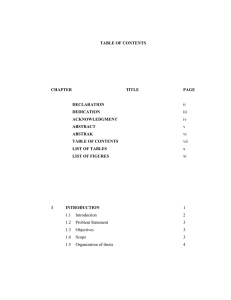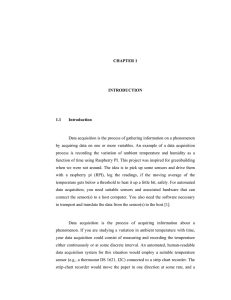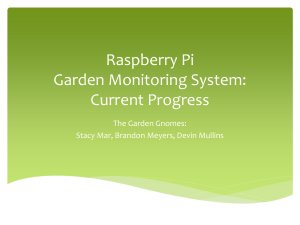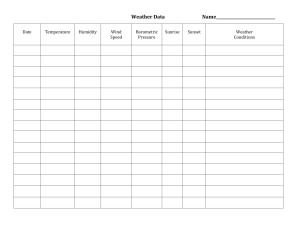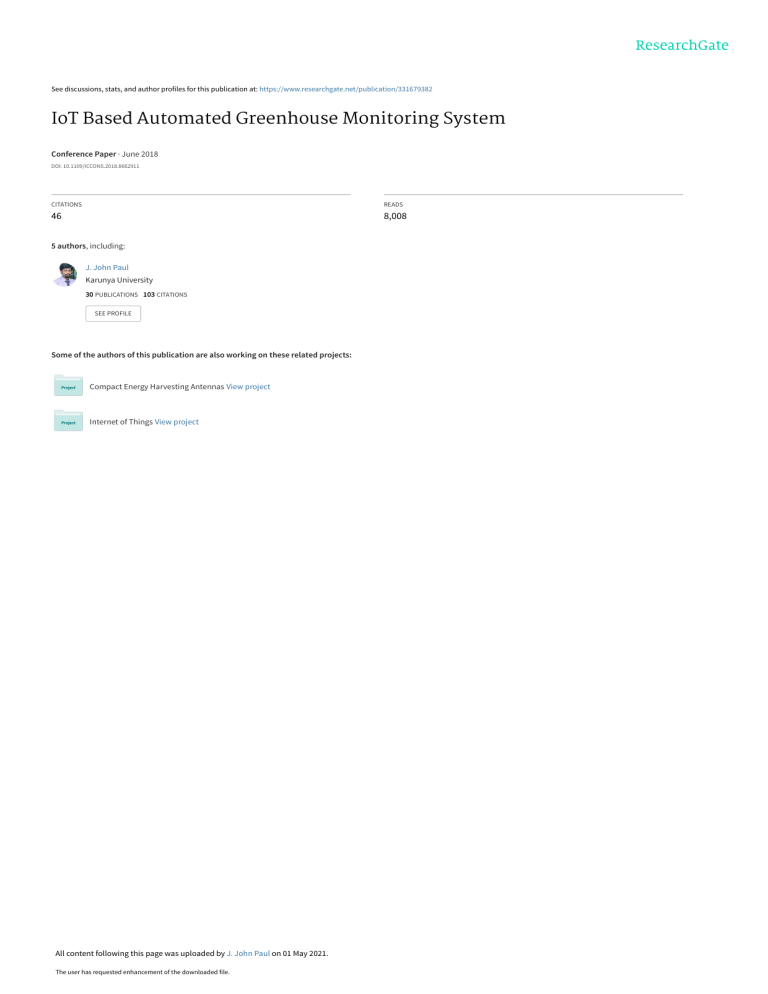
See discussions, stats, and author profiles for this publication at: https://www.researchgate.net/publication/331679382 IoT Based Automated Greenhouse Monitoring System Conference Paper · June 2018 DOI: 10.1109/ICCONS.2018.8662911 CITATIONS READS 46 8,008 5 authors, including: J. John Paul Karunya University 30 PUBLICATIONS 103 CITATIONS SEE PROFILE Some of the authors of this publication are also working on these related projects: Compact Energy Harvesting Antennas View project Internet of Things View project All content following this page was uploaded by J. John Paul on 01 May 2021. The user has requested enhancement of the downloaded file. Proceedings of the Second International Conference on Intelligent Computing and Control Systems (ICICCS 2018) IEEE Xplore Compliant Part Number: CFP18K74-ART; ISBN:978-1-5386-2842-3 IoT based Automated Greenhouse Monitoring System M. Danita, Blessy Mathew, Nithila Shereen, Namrata Sharon, J. John Paul School of Electrical Sciences Karunya Institute of Technology and sciences, Coimbatore, India danitam@karunya.edu.in, blessymathew@karunya.edu.in, rnithilashereen@karunya.edu.in, namratasharon@karunya.edu.in, johnpaul@karunya.edu Abstract— Greenhouses are climate controlled structures with walls and roof specially designed for offseason growing of plants. Most greenhouse systems use manual systems for monitoring the temperature and humidity which can cause discomfort to the worker as they are bound to visit the greenhouse every day and manually control them. Also, a lot of problems can occur as it affects the production rate because the temperature and humidity must be constantly monitored to ensure the good yield of the plants. Internet of Things is one of the latest advances in Information and Communication Technologies, providing global connectivity and management of sensors, devices, users with information. So the combination of IoT and embedded technology has helped in bringing solutions to many of the existing practical problems over the years. The sensors used here are YL69 moisture sensor and DHT11 (Temperature & Humidity sensor). From the data’s received, Raspberry PI3 automatically controls Moisture, Temperature, Humidity efficiently inside the greenhouse by actuating an irrigating pipe, cooling fan, and sliding windows respectively according to the required conditions of the crops to achieve maximum growth and yield. The recorded temperature and humidity are stored in a cloud database (ThingSpeak), and the results are displayed in a webpage, from where the user can view them directly. Keywords-IoT, Raspberry PI3, Greenhouse, ThingSpeak I. INTRODUCTION A greenhouse can be defined as a closed structure which is used to protect the plants from external factors such as climatic conditions, pollution, etc. It offers a sustainable and efficient development of the plants throughout the year. Basic factors affecting plant growth are sunlight, water content in soil, temperature, humidity etc. Numerous researchers have worked with water sprinkling and irrigation system. They opted for different methods for determining the soil moisture condition. An article on the automated water supply system for urban residential areas showed that their system can be used to effectively manage water resource. Required physical factors are hard to control manually inside a greenhouse so there is a need for the automated system [5]. Many smart irrigation systems have been proposed and devised through Evapotranspiration (ET), thermal imaging, capacitive methods, and neutron scattering method and gypsum blocks are some of the technologies that enable moisture sensing. Capacitive sensors, however instantaneous are costly and need to be calibrated often with varying temperature and soil type [2] [3]. G. Parameswaran et al. proposed “Arduino based smart irrigation system using Internet of Things” [11]. Kim et.al published a work on control of irrigation with distributed wireless sensor network [7]. K S. Nemali et al. Proposed irrigation systems which are also automated through information on volumetric water [9]. Chandankumar Sahu et al. proposed a system on “A Low Cost Smart Irrigation Control System” where the sensors are integrated with ESP8266 and the data received by ATMEGA-318 microcontroller which is on the ARDUINO-UNO development board [8]. Internet of things is a growing technology of the hour which enables us to access different data’s from any remote location as well. In this paper, our proposed system receives three parameters from the sensors and activates the actuators if the actual values are more than the threshold values and also stores these values in the cloud database enabling them to be accessed from anywhere, anytime. This paper also sheds light on the automatic control over the climatic conditions inside the greenhouse. There are different seasonal crops which can be grown only under certain conditions. Onions, garlic, shallots etc. are the winter crops which require cold conditions for their growth. Cucumbers, melons etc. are the summer crops which require moderate or hot climatic conditions. The prototype we used comprises of moisture sensors, temperature & humidity sensors, Raspberry PI and water pipes to supply water from tank controlled by DC motors. Moisture sensors (YL 69) are installed near the roots and temperature & humidity (DHT11) sensor is installed further away to detect the temperature and humidity. These sensors send their data to the Raspberry PI to analyze the results. The Raspberry PI will turn the inlet value on, to water the spinach, until the soil moisture value becomes greater than the threshold value. Inside the 978-1-5386-2842-3/18/$31.00 ©2018 IEEE 1933 Proceedings of the Second International Conference on Intelligent Computing and Control Systems (ICICCS 2018) IEEE Xplore Compliant Part Number: CFP18K74-ART; ISBN:978-1-5386-2842-3 greenhouse, if the temperature and humidity values are above the reference value (calculated according to the crop – spinach),to maintain them to be within the threshold levels, sliding door will be opened and fan will be switched ON. The existing system [6] consists of Manual Monitoring of the agricultural field parameters and the use of the GSM technology will take more time to get the required results. So in order to overcome that we have proposed more organized and automated monitoring of the crops by controlling different parameters inside the greenhouse. The Internet of Things is regarded as the third wave of information technology after Internet and mobile communication network, which is characterized by more thorough sense and measure, more comprehensive interoperability and intelligence. FIG 1.1 BLOCK DIAGRAM Fig 1.3 PIN DIAGRAM OF RASPBERRY PI 3 II. MODULES DESCRIPTION From the above figure 1.1 we can see the hardware required for this project a) Raspberry PI 3, b) moisture sensor YL69, c) DHT11 Temperature and humidity sensor, d) Motor driver IC l293d and e) Coolers and sliding windows. A) Raspberry PI 3 The heart of our project is the Raspberry PI 3 which is a single board computer which contains SOC. Raspberry PI 3 serves as a budget desktop and the core consists of the Arm processor. Some of its features include 40 GPIO pins, CPU speed of 1.2GHZ, 1 GB RAM of memory, Inbuilt Wi-Fi [1][12]. The Raspberry PI 3 will cost the same as its antecedent, but with an additional feature of Bluetooth and Wi-Fi. With its built-in wireless connectivity, the new Raspberry PI 3 is clearly placed as a low-cost hub for Internet of Things (IOT) devices, or flexible, low-cost basis on new types of connected gadgets [10]. To run the PI on a PC, we need to install Noobs OS on the SD card. Python programming is done on the putty software which is located on Windows platform so in order to run the putty software and Raspberry PI Linux platform simultaneously, we require XMING software. B) Moisture sensor (YL69) The YL69 is an inexpensive soil moisture sensor used to detect the amount of moisture content present in the soil. The operating voltage is 3.3v to 5v and current is 35mA.This sensor consists of two electrodes which when comes in contact with the soil the voltage fluctuates i.e. the output voltage decreases when the moisture is present and the output voltage increases when the soil is dry [4]. Fig 1.2 FLOWCHART Fig 1.4 YL69 MOISTURE SENSOR 978-1-5386-2842-3/18/$31.00 ©2018 IEEE 1934 Proceedings of the Second International Conference on Intelligent Computing and Control Systems (ICICCS 2018) IEEE Xplore Compliant Part Number: CFP18K74-ART; ISBN:978-1-5386-2842-3 C) Temperature & Humidity sensor (DHT11) DHT11 is one of the basic affordable digital sensors which can measure temperature and humidity. It has an operating voltage of 3 to 5 volts & max-current of 2.5mA.The temperature range lies between 0°C to 50°C, while the humidity percentage ranges between 20% to 80%. It consists of a thermistor which employs Negative Temperature Coefficient (NTC) and a humidity sensing component to detect the moisture in the air. III. METHODOLOGY To always sustain a suitable climate inside the greenhouse and to retain appropriate moisture content in the soil we have designed an automatic temperature control and irrigation system by monitoring the parameters temperature, humidity and soil moisture content using the temperature & humidity sensors (DHT11) and moisture sensors (YL69). The Whole Area inside the greenhouse is divided into multiple sections and one moisture sensor is placed in each section. The output of these moisture sensors is given to GPIO pins 2, 3, 4 of Raspberry PI. The output from PI is given to the driver IC which in turn operates the motor ON or OFF. The experimental plant used is Spinach. Soil Humidity - 50% Air Humidity- 14% Temperature - 250c Fig 1.5 DHT11 TEMPERATURE & HUMIDITY SENSOR D) Motor driver IC L293D L293D is a 16pin motor driver IC which has the ability to run two DC motors on both directions concurrently. DC motors cannot run directly without the use of a driver IC. Hence L293D crucially assists the motor to run. To the GPIO pin 17 of Raspberry PI, the serial output of the DHT11 sensor is connected. We have calculated a threshold value by the formula given below. (Threshold value) idx = Temperature+ (Humidity*0.1) =25+ (14*0.1) =26.4 If the temperature and humidity value exceeds the threshold value, then the cooling fan and sliding windows which are connected to l293d IC are automatically turned ON, thereby maintaining the humidity and temperature in the closed Green House system. The collected temperature and humidity data’s are sent to a ThingSpeak cloud through Wi-Fi connectivity. IV. REMOTE MONITORING Fig 1.6 MOTOR DRIVER IC L293D E) Coolers and sliding windows Coolers and sliding windows are installed on the side walls of a greenhouse to maintain the temperature and to regulate the airflow within the green house. Nowadays, billions of IoT devices, e.g., sensors and RFIDs, arise around us providing not only computing intensive, but also delay-sensitive services, ranging from augmented/virtual realities to distributed data analysis and artificial intelligence [6].Internet of things is a concept where each device is assigned an IP address and through that address, anyone makes that device identifiable on the internet. Nowadays internet is an evolving entity which started as the internet of computers. The major elements of IoT based greenhouse monitoring and automation systems are Raspberry PI, Relay as switch along with their driver circuits. This removes human interaction with machines and makes it technically possible and desirable in various domestic processes by replacing it with programmed electronic systems. Ultimately it is a system that aims to increase the quality of life with the automation of appliances that may be controlled over the internet. A) Communication With ThingSpeak Fig 1.7 COOLING FAN With the help of inbuilt Wi-Fi module, the data’s collected are uploaded to the ThingSpeak Cloud platform. We can visualize the data’s in the form of beautiful charts which features real-time updates. Using ThingSpeak IoT platform, we can continuously upload and monitor real-time data which will be very useful for the farmers. 978-1-5386-2842-3/18/$31.00 ©2018 IEEE 1935 Proceedings of the Second International Conference on Intelligent Computing and Control Systems (ICICCS 2018) IEEE Xplore Compliant Part Number: CFP18K74-ART; ISBN:978-1-5386-2842-3 V. RESULTS AND DISCUSSION B) ThingSpeak Cloud It is an IoT platform that is designed to enable meaningful connections between people and things. It features real-time data collection, data analysis, data processing, data visualization using a connected Social Networking Service (SNS) via an open source API to support various platforms. It helps to easily transfer data from embedded devices such as Arduino, Raspberry PI, NodeMCU, etc. Also, it supports various languages and environments. Our proposed system reads and sends sensor data using ThingSpeak. The main objective is to design and implement an automated system and to visualize sensed information as charts. The data obtained can be seen globally anywhere, anytime. A) HARDWARE SETUP Fig 3.1 HARDWARE SETUP C) Presentation To present the data in a useful form a webpage or APP can be developed. In our proposed system we have developed a webpage using HTML and CSS. To upload the data’s into the cloud platform, we have the option of creating a separate account in the ThingSpeak Cloud. When logged in, we created a new channel by selecting Channels >My Channels and then Create New Channel. The channel has its own unique API key which is used to identify the channel while reading or uploading data. The API allows making visualizations to be updated in real time. Each channel has up to eight fields where data can be stored as well as four additional fields for location details. All entries are stored with a unique identifier and a date and time stamp. B) VISUALISATION OF RESULTS D) Web page implementation: The whole setup is divided into two main segments first is the server side and the other is client or user side. The server can be created with the help of LAMP (Linux, Apache, MySQL, and PHP). HTML is used create a webpage and CSS is used to enhance the look of the webpage. Two HTML files are created in the local host as Server. To make it available on the internet these two HTML files are uploaded to the free server created by 000webhost.com. One is Index.html which is used to design the main page. If the sensed value goes beyond the threshold value set in the program then automatically the data’s will be uploaded on the webpage. In the webpage developed, the sensed data’s are continuously uploaded and the page gets refreshed every 16 seconds. As shown in Fig 3.2 the first page of the webpage is entitled to the system name and images. One link is made available to the end-user for which after pressing the link, opens up another new page as shown in Fig 3.1 where the sensor values are displayed in the graphical format. In that, First graph represents the temperature values and the second graph represents the humidity values. GUI shows the present status of the system in terms of soil moisture content, air humidity, temperature. From these parameters, the environmental conditions within the greenhouse are continuously monitored and maintained, enabling the necessary climatic conditions are always maintained in the Green house for the Spinach. Fig 3.2 FIRST PAGE OF THE WEB PAGE Fig 3.3 RESULTS DISPLAY ON THE SECOND PAGE Table 1. PRACTICAL CONDITIONS FOR SPINACH 978-1-5386-2842-3/18/$31.00 ©2018 IEEE 1936 Proceedings of the Second International Conference on Intelligent Computing and Control Systems (ICICCS 2018) IEEE Xplore Compliant Part Number: CFP18K74-ART; ISBN:978-1-5386-2842-3 From the above table, the Ideal threshold value for the spinach crop is found to be IdX = 26.5 (Humidity and Temperature) and for moisture it is 40%. 1. If the value exceeds 26.5, Raspberry PI automatically opens the sliding window and turns ON the Exhaust Fan. 2. If the value is less than 26.5, the Raspberry PI closes the sliding window and turns OFF the Exhaust fan. 3. If the moisture content is greater than 40%, then the Raspberry PI turns on the Sump motor, which in turn turns ON the water pump. 4. If the moisture content is less than 40%, then the Raspberry PI turns OFF the sump motor, which in turn turns ON the water pump. From the above results, the Ideal conditions necessary for the growth of the SPINACH crop is maintained automatically in a Closed Green House environment. VI. Conference on (ICECS), 2015. Electronics and Communication [9] Krishna S. Nemali, Marc W. van Iersel, “An automated system for controlling drought stress and irrigation in potted plants”, Scientia Horticulturae, Vol. 110, no. 3, pp. 292– 297,July 2006. [10] Tanu Sahu, Ashok Verma, “Automated Smart Irrigation System using Raspberry PI”, International Journal of Computer Applications, Volume 172 – No.6, August 2017 [11] Parameswaran, G., Sivaprasath, K, “Arduino Based Smart Drip Irrigation System Using Internet Of Things” IJESC, Volume 6 Issue No. 5,2016. [12] Nikhil Agrawal, Smita Singhal, “Smart Drip Irrigation system using Raspberry Pi and Arduino”, IEEE sponsored International Conference on computing, communication and automation, 2015. REFERENCES [1] Tanu Saha, Ashok Verma, “Automated Smart Irrigation system using Raspberry Pi”, International Journal of computer applications, Vol 172-No.6, August 2017. [2] D.Veera Vanitha, S.Nivitha, R.Pritha, J.Saranya, T.Shobika “Automatic Drip Irrigation System using Raspberry PI and Wireless Sensor Networks”. IJIRSET 2017. [3] F. S. Zazueta, and J. Xin “Soil Moisture Sensors” Bulletin 292; University of Florida: Gainsville, FL, USA, 2004. [4] Bhagyashree K.Chate , Prof.J.G.Rana “ Smart Irrigation System Using Raspberry PI”, IRJET May,2016. [5] N.B. Bhandarkar, D.P. Pande, R.S. Sonone, Mohd. Aaquib, P.A. Pandit, and P. D. Patil, "Literature Review for Automated Water Supply with Monitoring the Performance System", International Journal of Current Engineering and Technology, Vol. 4, No. 5, Oct 2014. [6] P.S. Asolkar, Dr. U.S Bhadade, “An Effective method of controlling the Greenhouse and Crop Monitoring using GSM”IEEE sponsored International Conference on Computing Communication Control and Automation,2015 [7] Kim, Yunseop, Robert G. Evans, and William M. Iversen, "Remote sensing and control of an irrigation system using a distributed wireless sensor network." IEEE Transactions on Instrumentation and Measurement, vol. 57, No.7, July 2008 [8] Chandankumar Sahu, Pramitee Behera, “A Low Cost Smart Irrigation Control System”, IEEE Sponsored 2nd International 978-1-5386-2842-3/18/$31.00 ©2018 IEEE View publication stats System 1937
